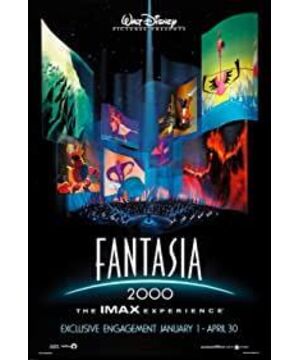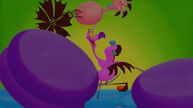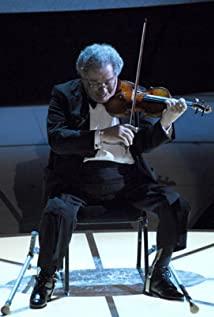The biggest feeling of the whole movie is that good ideas will never go out of style! If you are looking for fun and storytelling, obviously this movie is not so coherent. The independent chapters are destined to be short and concise plots. The solemnity of classical music will make some parts even seem a little boring. If you just want to see people How big is the brain hole, obviously this movie will surprise you, you will find that you have never thought that music can be interpreted in this way, and it is full of fun.
Ps: You don’t need to watch everything else, you have to watch the last paragraph! Beautiful to burst! ! !
The following is an introduction to each part. The birth of "Fantasia 2000" originated from the original version in 1940. Uncle Walter's idea of combining animation and classical music gave birth to the innovative "Fantasia 1940" at the time. It was a coincidence. I first came into contact with this edition in 2000. Generally speaking, each part is independent of each other but constitutes a complete audio-visual feast. The combination of color and music, the rhythm of images and notes, and the abstraction of music are transformed into concrete figures. The people of the movie really understand every piece of classical music, purely enjoy the journey. There are 8 movements in 2000, so let's talk about each part separately.
1. Beethoven: Symphony No.5 (Fate)
The first to appear is Beethoven’s "Symphony No. 5". This paragraph is only the opening stage, purely using some geometrical sound and shadow changes, the picture is very surreal, and the original 1940 "Fantasia" Bach's first paragraph "D minor touch technique and fugue" have the same effect. Beyond the surreal geometric figures, there seems to be a story or a philosophy. Colorful geometric figures and pure black geometric figures seem to be two opposites. Through the collision of colors, they tell a story of perseverance and self-improvement. Finally, the torn geometry breaks out of the pure black geometry and returns to its own colorful world. The unyielding will eventually arrive at the holy place in the heart when the cloud opens up and sees the moon.
2. Lespici: Pines of Rome (Pines of Rome)
The second paragraph is Respici’s "Roman Pine". The Roman Pine is derived from one of the Roman trilogy (Roman Spring, Roman Pine, Roman Festival). The trilogy is full of romance and vividness. Reflects the Roman style. The Roman Pine is the second part, which aims to evoke memories and hallucinations from the point of nature. The music is divided into four sections, and the movie uses the whale as the protagonist to show the changes and emotions of the whole music. At the beginning is this group of whales swimming in the sea. The overall picture is very beautiful. The liveliness of the young whales reflects the liveliness and innocence of the children in the first paragraph of the music. The playfulness of the young whales attracts the flock of gulls. In order to avoid the gulls, he panicked and strayed into the land of no one. At this time, the music just transferred to the second section of the pine of the tomb. The whole piece of music was full of sadness and solemnity. The artist turned the deep and deep of the music into the loneliness of a baby whale. , The figure of mother and father were reflected on the huge dome, but they couldn't see each other, separated by a wall, two worlds. With the emergence of a beam of light, the music shifts to the third section of the mountain pine. The tuning body is full of peace and tranquility. The baby whale rides on the light and swims upwards, gathering with parents at the top, echoing the harmony in the music. Coming to the pine of the fourth section of the avenue, the bright sunshine and the aggressiveness of the conquerors replaced the previous gentleness. The whales flew from the deep sea to the blue sky, through the clouds, freed from the shackles of the real world and swim in the golden ocean, power and beauty. coexist.
3. Gershwin: Rhapsody in Blue
"Rhapsody in Blue" is completely different from the pure classical music of other passages. This passage uses a modern jazz style. The background is in the New York Metropolis of the 1930s. This passage uses bold colors and lines. Presenting the weirdness of cosmopolitan life. At a time when American music has not yet formed, the appearance of Rhapsody in Blue gives the confused America an American style, so it is called the most American-spirited music. This characteristic is also from animation. It can be seen. Different people have different worries. What others have is what they expect, and what they have is what others want. In a life that is not in line, everyone has their own worries and dreams, with the escape of music, animation The transition is very ingenious and natural. In the end, everyone lives the life they expect in an unexpected way. Although the process is full of American humor, the spirit of finally getting everyone's wishes and the inner spirit of music are unified. It is a condensed American-style story, and the painter has grasped it well.
4. Shostakovich: Piano Concerto No. 2-Fast Version (Piano Concerto No. 2, Allegro, Opus 102)
Shostakovich’s "Piano Concerto No. 2" is Andersen’s famous fairy tale "The Resolute Tin Soldier". It tells the love story of a one-legged toy tin soldier and a toy ballet dancer. In the original fairy tale, the tin soldier was melted. It was dropped, but the result was slightly changed in this movie. Disney's style is naturally so evil, and lovers eventually become married.
5. Saint-Saëns: Carnival of the Animals
"Animal Carnival" describes a group of flamingoes with the same actions, but because one of the flamingoes is obsessed with playing yo-yo, the whole group of flamingoes is in a mess. This flamingo’s posture playing with a yo-yo is very funny. The water splashed everywhere, and the companion suffered. Compared with the other parts, this part is shorter and more lively and joyous. It seems to have come to a circus carnival banquet, watching a funny performance of flamingoes, and it is generally relaxed and cheerful.
6. Duka: "The Sorcerer's Apprentice" (The Sorcerer's Apprentice)
"The Magician's Apprentice" is a reserved section of "Fantasia 1940". The film is starred by Disney's signature star Mickey. In the film, Mickey lazily casts spells. After falling asleep, he even dreamed of commanding the waves and stars. He did not expect to wake up. I found out that the flood was flooded, and the result was a mess. The animation is quite dreamy, especially when the stars are falling, magic! ?
7. Elgar: Pomp & Circumstance
"Awe-inspiring March" is the story of "Noah's Ark" in the Bible. This time Disney asked Donald Duck to play Noah. When the storm came, a large number of animals boarded the boat, and later it was even affected by the turbulent flood. Fighting, finally calm and calm, all the animals boarded the deck of the boat, facing the bright future together. What’s interesting is that Donald Duck rarely keeps the character’s funny but not inconsistent under the background of the march. The clever plot design makes the whole piece of music seem like the journey of Donald Duck and Daisy. The highest note is played in the unexpected encounter. The plot is simple but fascinating, interesting and interesting.
8. Stravinsky: Firebird Suite (Firebird Suite)
The last paragraph is Stravinsky’s "Firebird Suite". Whether it is the endless life of all things in nature, or the firebird flying and burning the entire sky, the changes in light and shadow presented in the film bring to the viewers The visual shock seems to have seen a blockbuster movie, drawing a gorgeous end to "Fantasia 2000". It's hard to imagine that a painter can paint the soft texture of water so smoothly, beautifully and imaginatively. The entire paragraph is full of tension and the colors are incredibly healing, so beautiful that there is nothing to say! You don't need to watch the first one, and the last one must not be missed! ! ! ! !
View more about Fantasia 2000 reviews











